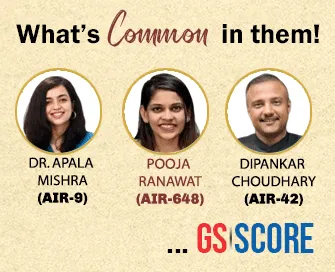


Instruction:
- There will be 2 questions carrying 10 marks each. Write your answers in 150 words
- Any page left blank in the answer-book must be crossed out clearly.
- Evaluated Copy will be re-uploaded on the same thread after 2 days of uploading the copy.
- Discussion of the question and one to one answer improvement session of evaluated copies will be conducted through Google Meet with concerned faculty. You will be informed via mail or SMS for the discussion.
Question #1. Discuss the application of Geomorphic knowledge in dealing with Hydrological problems of limestone regions?
Question #2. Discuss with examples the application of geomorphology to mineral and oil exploration
(Examiner will pay special attention to the candidate's grasp of his/her material, its relevance to the subject chosen, and to his/ her ability to think constructively and to present his/her ideas concisely, logically and effectively).
STEPS & INSTRUCTIONS for uploading the answers
Step 1 - The Question for the day is provided below these instructions. It will be available at 7:00 AM.
Step 2 - Uploading of Answers : Write the answer in A4 Sheet leaving proper margins for comments and feedback and upload the PDF in MY ACCOUNT section. Click on the option of SUBMIT COPY to upload the PDF.
Step 3 - Deadline for Uploading Answers: The students shall upload their answers by 7:00 PM in the evening same day. The first 50 copies will be evaluated.
Step 4 - Feedback : Mentors will give their feedback for the answers uploaded. For more personalised feedback, join our telegram channel by clicking on the link https://t.me/mains_answer_writing_cse . A one-to-one session will be conducted with the faculty after copy evaluation in 72 Hrs.
Model Answer
Question #1. Discuss the application of Geomorphic knowledge in dealing with Hydrological problems of limestone regions?
Ans- Hydrology is a science of water, its properties and distribution over the globe. Hardly 1% of the total water on the earth is available for drinking and this too is unevenly distributed. Limestone or Karst regions suffers from the limited availability of surface streams, unpredictability of land and issue of potable water free from pollutants. In this context Knowledge of geomorphology will help planners and inhabitants to create a sustainable equation with land.
Ground and surface water in karst regions is intimately linked with stratigraphy and lithological zones. Porosity and permeability of limestone rocks is an important determinant behind the hydrology of these regions. Much of the groundwater in Karst regions is confined to solution holes, channels and caverns developed in the latter phase of cycle of erosion and consequent disappearance of surface streams.
As polluted water through rainfall enter through sink hole and lack of geomaterial filtering makes karst spring unfit for drinking and human use. Construction of Dams and reservoir needs thorough survey and prior investigations of subterrain drainage and hydrology along with structural issues present in terms of permeability.
Geomorphic information of limestone areas helps in digging wells for good quality water. If limestone is capped with sandstone layer of later formations than there is a possibility for rich groundwater which is filtered while passing through sandstone beds and free from pollutants.
Mining in limestone regions also generate issues related to water quality. Recent studies conducted in Meghalaya is concerned about declining water quality and collapse of hills along with problems of availability of potable water.
Thus understanding of structure, lithology and process operating on land along with factor of time will help in understanding and exploring the water resources of limestone regions and its effects on settlements around such regions.
Source: P Dayal, Savinder Singh, Thornburry, Huggett, Research Gate journals
Question #2. Discuss with examples the application of geomorphology to mineral and oil exploration
Ans- Mineral deposit is closely associated with geological structure, surface expression of landforms and relief features of the specific landscape. Thus knowledge of geomorphic history provides insights related to evolution of landscape, which can be further used as an exploratory tool in the search of minerals.
Some of the minerals are associated with specific and distinct topographic expressions. Massive outcrops of hematite and magnetite occur as a hills in the rocks of Dharwad system of peninsular India. Similarly in the singhbhum and Mayurbhanj region of Jharkhand and Orissa founds one of the richest and largest iron-ore deposits of the world which stands out as an inclined hills. Precambrian deposits in lake superior region regions of USA commonly referred as Iron Ore range. Viens of Quartz , lead-Zinc also expressed as ridges and stands out as distinct relief.
Denudation history helps in locating residue minerals like some iron-ore, clay minerals, caliche, bauxite, manganese, nickel etc. As Minerals changes their positions during the earlier stages cycle of erosion and get settled during later stage. They are commonly found on remnants of tertiary erosional surfaces or along ancient peneplains buried under later deposits. Banded iron formations and bauxites of Patlands in Ranchi, India are typical examples of residual minerals. These pats are also clearcut expressions of bauxite.
Study of depositional features of different geomorphic agents in varying environmental conditions helps in locating placer deposits which contains precious metals like gold, diamond, silver etc. These superficial deposits are carried by rivers, wind and glaciers . For example colluvium , alluvium, bajada and beach placer contains gold, platinum, tin and diamond.
Geomorphic principles also helps in the exploration of mineral oil. Mineral oil is found in the porous and permeable lithologies having impermeable basement layer. Folded structures of sedimentary formation are most probable location of mineral oil occurrences. Anticlines and synclines allows permeable strata to come close to impermeable strata so that mineral oil is well confined and preserved within the upper permeable and lower impermeable strata.
Thus geomorphological knowledge may be applied and by using of techniques of morphological mapping and remote sensing this knowledge is of immense benefit for fruitful and economical exploration of minerals and their extractions.
Source: P Dayal, Savinder Singh, Thornburry, Huggett, Research Gate journals
Applied Geomorphology:


